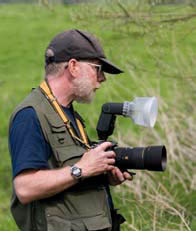articles/Lens/gettingclose-page4
Getting close with SIGMA - part 4 of 1 2 3 4 5
by Mike McNamee Published

When it comes to shiny objects such as jewellery, nothing comes close to the DeVille Dome for even lighting and the absence of distracting reflections. Here the author's 45cm top aperture model in use for this review. DeVille domes are available from Bob Rigby Photographic. See adverts in Professional Imagemaker.
Mechanical
The flash unit is a little short of 5 inches square at the front. This front unit contains the two flash tubes plus a pair of focussed illumination lights for low light-level assistance with focussing. Each tube is independently controllable and the entire flash unit can be rotated to change the modelling of the light and when the camera is rotated from say landscape to portrait format. An 8mm diameter cable links the flash head to the power supply from the control unit. This control unit is a modified flash head of the conventional design except that there is no flash in it. The EM 140 comes with a handy carrying case, which has space for accessories such as additional adaptor and spare batteries. It is the size of a medium-size handbag. The flash and controller weighs 430g without batteries.
bearing in mind that the capacitor in the controller is normal sized you might expect to get about 100 shots from NiMH and 200 from a Duracell.
The flash guide number is 14 although this is slightly irrelevant in view of the intended use. The inverse square law tends to break down at such close distances. A more practical measure is the working aperture you can expect at different working distances. Using the Sigma 150mm lens, the longer end of the macro lens population we found we could get f22 at 0.8 metres and f11 at 2 metres using ISO 200. This is plenty for most uses. If you wish to use the macro system as a "fashion" shoot accessory then you can expect to be using an aperture around f5.6 at 3 metres. The coverage of the EM 140 is high at 80° in both the vertical and horizontal planes.
The flash recycle time was 2.8s on brand new Duracells and 3.4s on freshly charged NiMH cells. Sigma recommends you change batteries when the recharge time exceeds 30 seconds. This is way too long - no self-respecting dragonfly is going to sit there for that sort of time!

A slightly ragged Holly Blue but nothing ragged about the resolution. Details in the main text.
In Use
We paired the EM-140 with the new Sigma 150mm F2.8 Macro. This lot, attached to a Nikon D100 was quite a weight at 5lb (2.3Kg) and so the rotating tripod bush is quite useful in the field.
Allowing the flash to shoot on automatic with flash set to TTL was not very satisfactory on flowers. Yellow pansies tended to be under exposed by as much as two stops. TTL flash only allows two flash tubes to fire or either side at full power. To obtain controlled modelling it is necessary to go to fully manual exposure and then you can tune each tube to whole stop increments between full power and 1/64th power.
For manual shooting we developed a curve for the correct exposure aperture at different magnifications. To provide modelling we set one tube to ¼ power and the other to 1/16th power. This enabled us to use f16 at 1:1 magnification an effective aperture of f32.
Please Note:
There is more than one page for this Article.
You are currently on page 4
- Getting close with SIGMA page 1
- Getting close with SIGMA page 2
- Getting close with SIGMA page 3
- Getting close with SIGMA page 4
- Getting close with SIGMA page 5
1st Published
last update 09/12/2022 14:54:40
More Lens Articles
There are 28 days to get ready for The Society of Photographers Convention and Trade Show at The Novotel London West, Hammersmith ...
which starts on Wednesday 14th January 2026




